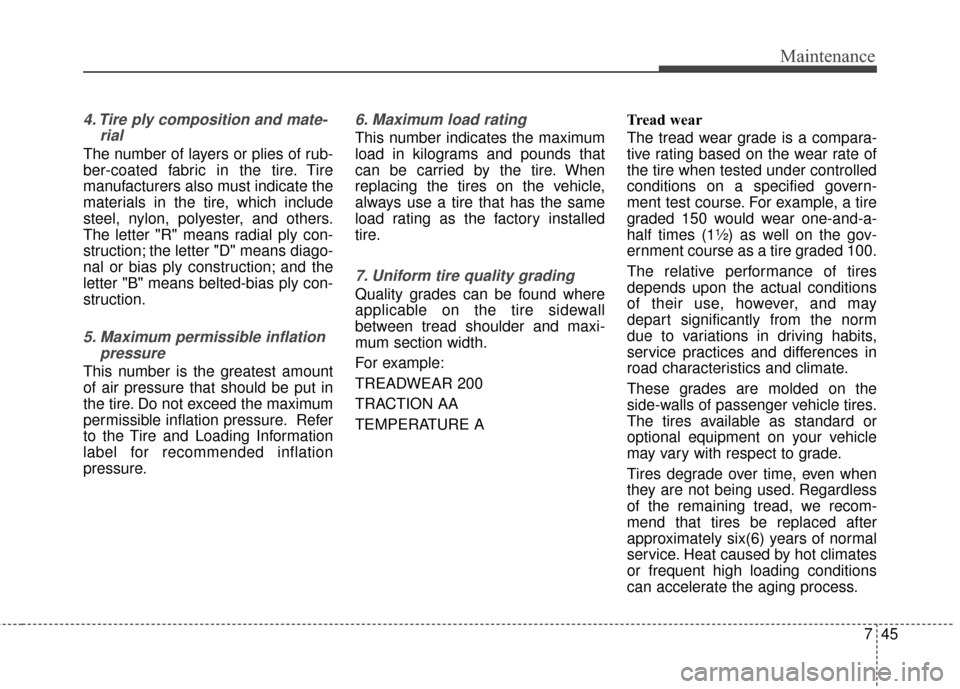2016 Hyundai Azera traction control
[x] Cancel search: traction controlPage 462 of 521

745
Maintenance
4. Tire ply composition and mate-rial
The number of layers or plies of rub-
ber-coated fabric in the tire. Tire
manufacturers also must indicate the
materials in the tire, which include
steel, nylon, polyester, and others.
The letter "R" means radial ply con-
struction; the letter "D" means diago-
nal or bias ply construction; and the
letter "B" means belted-bias ply con-
struction.
5. Maximum permissible inflationpressure
This number is the greatest amount
of air pressure that should be put in
the tire. Do not exceed the maximum
permissible inflation pressure. Refer
to the Tire and Loading Information
label for recommended inflation
pressure.
6. Maximum load rating
This number indicates the maximum
load in kilograms and pounds that
can be carried by the tire. When
replacing the tires on the vehicle,
always use a tire that has the same
load rating as the factory installed
tire.
7. Uniform tire quality grading
Quality grades can be found where
applicable on the tire sidewall
between tread shoulder and maxi-
mum section width.
For example:
TREADWEAR 200
TRACTION AA
TEMPERATURE A Tread wear
The tread wear grade is a compara-
tive rating based on the wear rate of
the tire when tested under controlled
conditions on a specified govern-
ment test course. For example, a tire
graded 150 would wear one-and-a-
half times (1½) as well on the gov-
ernment course as a tire graded 100.
The relative performance of tires
depends upon the actual conditions
of their use, however, and may
depart significantly from the norm
due to variations in driving habits,
service practices and differences in
road characteristics and climate.
These grades are molded on the
side-walls of passenger vehicle tires.
The tires available as standard or
optional equipment on your vehicle
may vary with respect to grade.
Tires degrade over time, even when
they are not being used. Regardless
of the remaining tread, we recom-
mend that tires be replaced after
approximately six(6) years of normal
service. Heat caused by hot climates
or frequent high loading conditions
can accelerate the aging process.
Page 463 of 521

Maintenance
46
7
Traction - AA, A, B & C
The traction grades, from highest to
lowest, are AA, A, B and C. Those
grades represent the tire’s ability to
stop on wet pavement as measured
under controlled conditions on speci-
fied government test surfaces of
asphalt and concrete. A tire marked C
may have poor traction performance.
The traction grade assigned to this
tire is based on straight-ahead brak-
ing traction tests, and does not
include acceleration, cornering,
hydroplaning, or peak traction char-
acteristics.
Temperature -A, B & C
The temperature grades are A (the
highest), B and C representing the
tire’s resistance to the generation of
heat and its ability to dissipate heat
when tested under controlled condi-
tions on a specified indoor laboratory
test wheel. Sustained high temperature can
cause the material of the tire to
degenerate and reduce tire life, and
excessive temperature can lead to
sudden tire failure. The grade C cor-
responds to a level of performance
which all passenger car tires must
meet under the Federal Motor
Vehicle Safety Standard No. 109.
Grades B and A represent higher
levels of performance on the labora-
tory test wheel than the minimum
required by law.Low aspect ratio tire
Low aspect ratio tires, whose aspect
ratio is lower than 50, are standard
equipment on this vehicle.
Because the low aspect ratio tires
are optimized for handling and brak-
ing, it may be more uncomfortable to
ride in and there is more noise com-
pare with normal tires.
WARNING - Tire
temperature
The temperature grade for this
tire is established for a tire that
is properly inflated and not
overloaded. Excessive speed,
underinflation, or excessive
loading, either separately or in
combination, can cause heat
build-up and possible sudden
tire failure. This can cause loss
of vehicle control and serious
injury or death.
CAUTION
Because the sidewall of the low aspect ratio tire is shorter thanthe normal, the wheel and tire ofthe low aspect ratio tire can eas-ily be damaged. So, follow theinstructions below.
or off road, drive cautiouslybecause tires and wheels maybe damaged. And after driving,inspect tires and wheels.
When passing over a pothole, speed bump, manhole, or curbstone, drive slowly so that thetires and wheels are not dam-aged.
(Continued)
Page 519 of 521

Index
10I
Special driving conditions ............................................5-75Driving at night ........................................................5-76
Driving in flooded areas............................................5-77
Driving in the rain ....................................................5-77
Hazardous driving conditions ..................................5-75
Highway driving........................................................5-78
Rocking the vehicle ..................................................5-75
Smooth cornering ......................................................5-76
Speedometer ..................................................................4-59
Sports mode ..................................................................5-12
SRS components and functions ....................................3-38
Starting difficulties, see engine will not start ..................6-4
Steering wheel ..............................................................4-43 Electronic power steering (EPS) ..............................4-43
Horn ........................................................................\
..4-45
Tilt and telescopic steering........................................4-44
Steering wheel audio control ......................................4-146
Steps For Determining Correct Load Limit ..................5-84
Storage compartment ..................................................4-137 Center console storage ............................................4-137
Glove box ................................................................4-137
Sunglass holder ......................................................4-138
Sunglass holder ............................................................4-138
Sunroof, see panoramic sunroof ..................................4-35
Sunvisor ......................................................................4-\
140
Sunvisor lamp, see vanity mirror lamp........................4-111 Tachometer ....................................................................4-59\
Tether anchor system ....................................................3-33
Theft-alarm system ........................................................4-12
Tie-down hook ..............................................................6-24
Tilt and telescopic steering ............................................4-44
Tire and loading information label ................................5-83
Tire chains......................................................................5-\
80
Tire pressure monitoring system (TPMS) ......................6-8
Tire specification and pressure label ..............................8-8
Tires and wheels ............................................................7-37
Checking tire inflation pressure ................................7-38
Compact spare tire replacement ................................7-41
Low aspect ratio tire..................................................7-46
Recommended cold tire inflation pressures ..............7-37
Tire care ....................................................................7-37\
Tire maintenance ......................................................7-42
Tire replacement ................................................7-40, 8-3
Tire rotation ..............................................................7-39
Tire sidewall labeling ................................................7-43
Tire traction ..............................................................7-42
Wheel alignment and tire balance ............................7-40
Wheel replacement ............................................7-42, 8-3T